中考英语语法考点知识复习-反义疑问句
- 格式:doc
- 大小:115.28 KB
- 文档页数:22
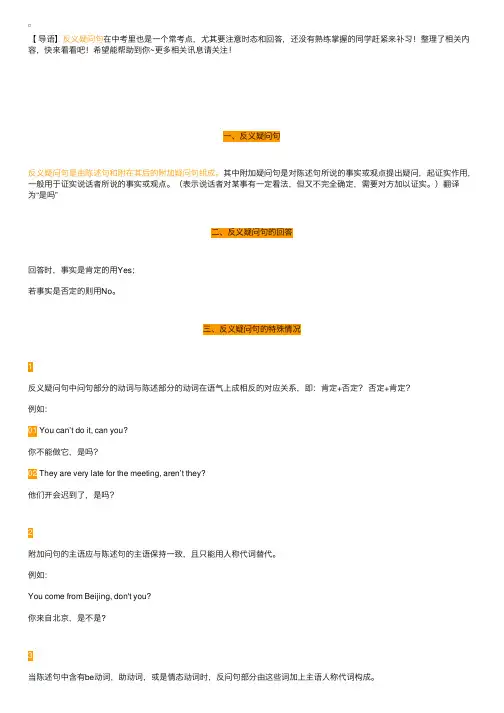
【导语】反义疑问句在中考⾥也是⼀个常考点,尤其要注意时态和回答,还没有熟练掌握的同学赶紧来补习!整理了相关内容,快来看看吧!希望能帮助到你~更多相关讯息请关注!⼀、反义疑问句反义疑问句是由陈述句和附在其后的附加疑问句组成。
其中附加疑问句是对陈述句所说的事实或观点提出疑问,起证实作⽤,⼀般⽤于证实说话者所说的事实或观点。
(表⽰说话者对某事有⼀定看法,但⼜不完全确定,需要对⽅加以证实。
)翻译为“是吗”⼆、反义疑问句的回答回答时,事实是肯定的⽤Yes;若事实是否定的则⽤No。
三、反义疑问句的特殊情况1反义疑问句中问句部分的动词与陈述部分的动词在语⽓上成相反的对应关系,即:肯定+否定?否定+肯定?例如:01 You can’t do it, can you?你不能做它,是吗?02 They are very late for the meeting, aren’t they?他们开会迟到了,是吗?2附加问句的主语应与陈述句的主语保持⼀致,且只能⽤⼈称代词替代。
例如:You come from Beijing, don't you?你来⾃北京,是不是?3当陈述句中含有be动词,助动词,或是情态动词时,反问句部分由这些词加上主语⼈称代词构成。
Be动词包括:am, is, are, was, were助动词有:do, does, did, have(⽤在完成时), has(⽤在完成时)等情态动词有:can, could, may, might, must, will, would, shall, should例如:01 He will go home, won’t he?他要回家了,是吗?02 She doesn’t like to eat popcorn, does she?她不喜欢吃爆⽶花,是吗?4have的不同⽤法,反义疑问句⽤不同的动词。
(1)have表“有”时,反义疑问句谓语动词⽤have/do都⾏。
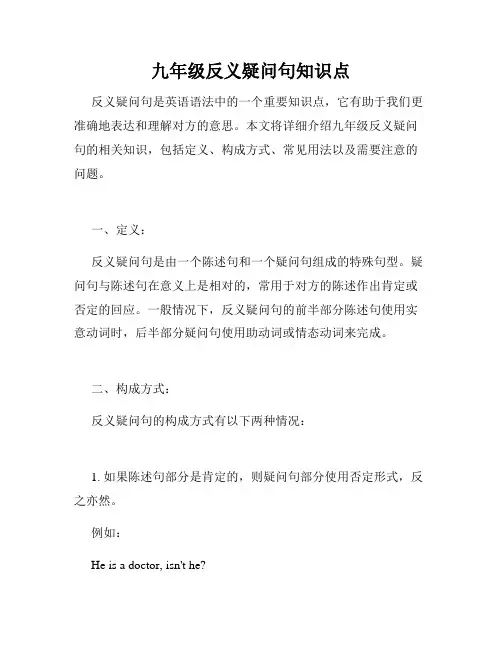
九年级反义疑问句知识点反义疑问句是英语语法中的一个重要知识点,它有助于我们更准确地表达和理解对方的意思。
本文将详细介绍九年级反义疑问句的相关知识,包括定义、构成方式、常见用法以及需要注意的问题。
一、定义:反义疑问句是由一个陈述句和一个疑问句组成的特殊句型。
疑问句与陈述句在意义上是相对的,常用于对方的陈述作出肯定或否定的回应。
一般情况下,反义疑问句的前半部分陈述句使用实意动词时,后半部分疑问句使用助动词或情态动词来完成。
二、构成方式:反义疑问句的构成方式有以下两种情况:1. 如果陈述句部分是肯定的,则疑问句部分使用否定形式,反之亦然。
例如:He is a doctor, isn't he?He isn't a doctor, is he?2. 如果陈述句部分使用助动词或情态动词,疑问句部分使用主要动词。
例如:You can swim, can't you?You can't swim, can you?三、常见用法:九年级阶段,学生需要掌握反义疑问句的常见用法,以下是一些例子:1. 表示请求或征求对方的意见或确认:You will come to the party, won't you?Let's go for a walk, shall we?2. 表示对方的推测并确认:She is your sister, isn't she?3. 表示对方的意见并征求同意或否定:You don't mind if I sit here, do you?4. 表示对方的实际情况并征求确认:You have finished your homework, haven't you?四、需要注意的问题:在使用反义疑问句时,需要注意以下几个问题:1. 人称和时态的一致性:主语的人称和时态需与疑问句的主语相对应,否则会造成语法错误。
例如:She is a doctor, isn't they?(错误)She is a doctor, isn't she?(正确)2. 答案的选择:对于反义疑问句,回答要根据前半部分陈述句而定。
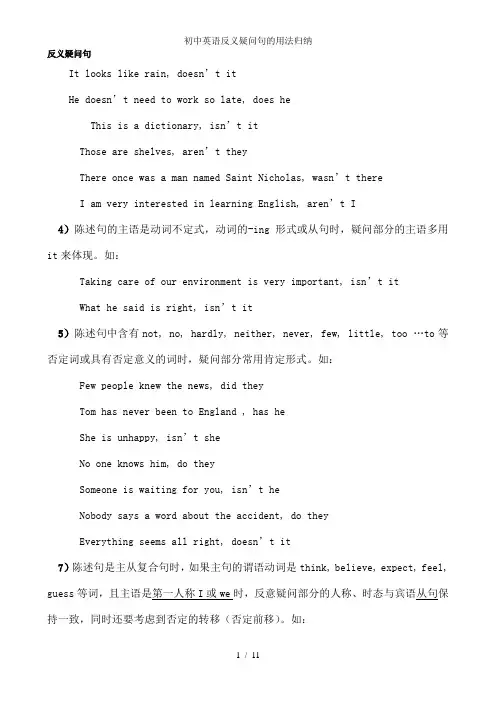
反义疑问句It looks like rain, doesn’t itHe doesn’t need to work so late, does heThis is a dictionary, isn’t itThose are shelves, aren’t theyThere once was a man named Saint Nicholas, wasn’t thereI am very interested in learning English, aren’t I4)陈述句的主语是动词不定式,动词的-ing形式或从句时,疑问部分的主语多用it来体现。
如:Taking care of our environment is very important, isn’t itWhat he said is right, isn’t it5)陈述句中含有not, no, hardly, neither, never, few, little, too …to等否定词或具有否定意义的词时,疑问部分常用肯定形式。
如:Few people knew the news, did theyTom has never been to England , has heShe is unhappy, isn’t sheNo one knows him, do theySomeone is waiting for you, isn’t heNobody says a word about the accident, do theyEverything seems all right, doesn’t it7)陈述句是主从复合句时,如果主句的谓语动词是think, believe, expect, feel, guess等词,且主语是第一人称I或we时,反意疑问部分的人称、时态与宾语从句保持一致,同时还要考虑到否定的转移(否定前移)。
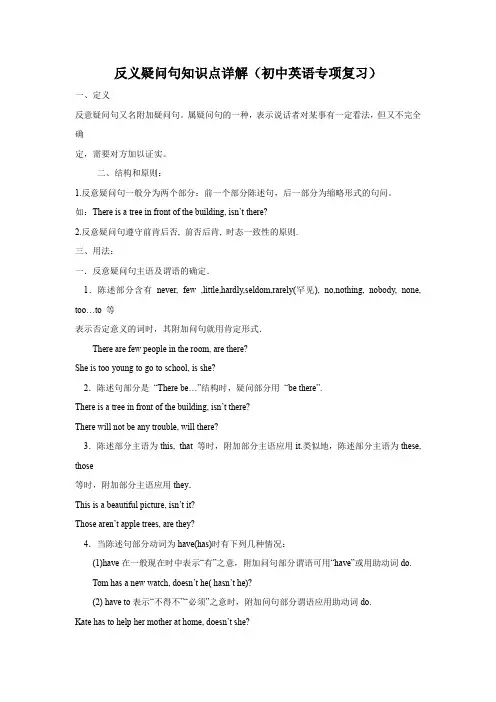
反义疑问句知识点详解(初中英语专项复习)一、定义反意疑问句又名附加疑问句。
属疑问句的一种,表示说话者对某事有一定看法,但又不完全确定,需要对方加以证实。
二、结构和原则:1.反意疑问句一般分为两个部分:前一个部分陈述句,后一部分为缩略形式的句问。
如:There is a tree in front of the building, isn’t there?2.反意疑问句遵守前肯后否, 前否后肯, 时态一致性的原则.三、用法:一.反意疑问句主语及谓语的确定.1.陈述部分含有never, few ,little,hardly,seldom,rarely(罕见), no,nothing, nobody, none, too…to 等表示否定意义的词时,其附加问句就用肯定形式.There are few people in the room, are there?She is too young to go to school, is she?2.陈述句部分是“There be…”结构时,疑问部分用“be there”.There is a tree in front of the building, isn’t there?There will not be any trouble, will there?3.陈述部分主语为this, that 等时,附加部分主语应用it.类似地,陈述部分主语为these, those等时,附加部分主语应用they.This is a beautiful picture, isn’t it?Those aren’t apple trees, are they?4.当陈述句部分动词为have(has)时有下列几种情况:(1)have在一般现在时中表示“有”之意,附加问句部分谓语可用“have”或用助动词do.Tom has a new watch, doesn’t he( hasn’t he)?(2) have to表示“不得不”“必须”之意时,附加问句部分谓语应用助动词do.Kate has to help her mother at home, doesn’t she?(3) have 表示“吃、喝、玩、度过”等意时,其附加问句的谓语应用助动词do.They have a good time in Beijing, don’t they?(4)have 在完成时中,其附加问句谓语动词应用have.Lucy has ever been to Japan, hasn’t she?(5) had better 最好,在祈使句中,其附加问句谓语动词应用hadYou had better clean the room,hadn’t you?5.肯定的祈使句的附加问句可用will you或won’t you,否定的祈使句的附加问句用will you.Listen to me carefully, will you?Don’t play with fire, will you?6.以let’s开头的祈使句,附加问句用shall we;而以let us 开头的祈使句,附加问句用will you.Let’s go to the park, shall we?Let us help you, will you?7.think, believe, expect, imagine, suppose等引导的宾语从句:A.主语是第一人称(应特别注意否定的转移)I don’t think he is bright, is he?We believe she can do it better, can’t she?B. 如果主语不是第一人称则疑问部分与主句相对应构成反意疑问句He thought they were wrong, didn’t he?8.否定前缀或后缀(否定前缀dis-, un-, im-或否定后缀-less,如dislike, discourage, unfair, unable等)不能视为否定词,其反意疑问句仍用否定形式。
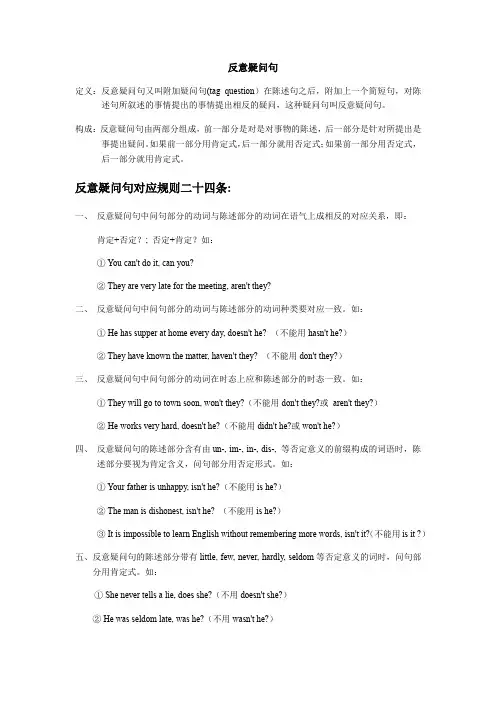
反意疑问句定义:反意疑问句又叫附加疑问句(tag question)在陈述句之后,附加上一个简短句,对陈述句所叙述的事情提出的事情提出相反的疑问,这种疑问句叫反意疑问句。
构成:反意疑问句由两部分组成,前一部分是对是对事物的陈述,后一部分是针对所提出是事提出疑问。
如果前一部分用肯定式,后一部分就用否定式;如果前一部分用否定式,后一部分就用肯定式。
反意疑问句对应规则二十四条:一、反意疑问句中问句部分的动词与陈述部分的动词在语气上成相反的对应关系,即:肯定+否定?; 否定+肯定?如:① You can't do it, can you?② They are very late for the meeting, aren't they?二、反意疑问句中问句部分的动词与陈述部分的动词种类要对应一致。
如:① He has supper at home every day, doesn't he? (不能用hasn't he?)② They have known the matter, haven't they? (不能用don't they?)三、反意疑问句中问句部分的动词在时态上应和陈述部分的时态一致。
如:① They will go to town soon, won't they?(不能用don't they?或aren't they?)② He works very hard, doesn't he?(不能用didn't he?或won't he?)四、反意疑问句的陈述部分含有由un-, im-, in-, dis-, 等否定意义的前缀构成的词语时,陈述部分要视为肯定含义,问句部分用否定形式。
如:① Your father is unhappy, isn't he?(不能用is he?)② The man is dishonest, isn't he? (不能用is he?)③ It is impossible to learn English without remembering more words, isn't it?(不能用is it ?)五、反意疑问句的陈述部分带有little, few, never, hardly, seldom等否定意义的词时,问句部分用肯定式。

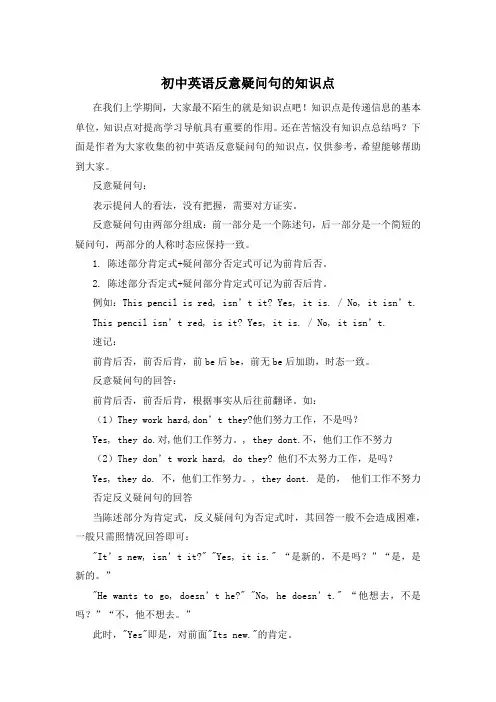
初中英语反意疑问句的知识点在我们上学期间,大家最不陌生的就是知识点吧!知识点是传递信息的基本单位,知识点对提高学习导航具有重要的作用。
还在苦恼没有知识点总结吗?下面是作者为大家收集的初中英语反意疑问句的知识点,仅供参考,希望能够帮助到大家。
反意疑问句:表示提问人的看法,没有把握,需要对方证实。
反意疑问句由两部分组成:前一部分是一个陈述句,后一部分是一个简短的疑问句,两部分的人称时态应保持一致。
1. 陈述部分肯定式+疑问部分否定式可记为前肯后否。
2. 陈述部分否定式+疑问部分肯定式可记为前否后肯。
例如:This pencil is red, isn’t it? Yes, it is. / No, it isn’t.This pencil isn’t red, is it? Yes, it is. / No, it isn’t.速记:前肯后否,前否后肯,前be后be,前无be后加助,时态一致。
反意疑问句的回答:前肯后否,前否后肯,根据事实从后往前翻译。
如:(1)They work hard,don’t they?他们努力工作,不是吗?Yes, they do.对,他们工作努力。
, they dont.不,他们工作不努力(2)They don’t work hard, do they? 他们不太努力工作,是吗?Yes, they do. 不,他们工作努力。
, they dont. 是的,他们工作不努力否定反义疑问句的回答当陈述部分为肯定式,反义疑问句为否定式时,其回答一般不会造成困难,一般只需照情况回答即可:"It’s new, isn’t it?" "Yes, it is." “是新的,不是吗?”“是,是新的。
”"He wants to go, doesn’t he?" "No, he doesn’t." “他想去,不是吗?”“不,他不想去。
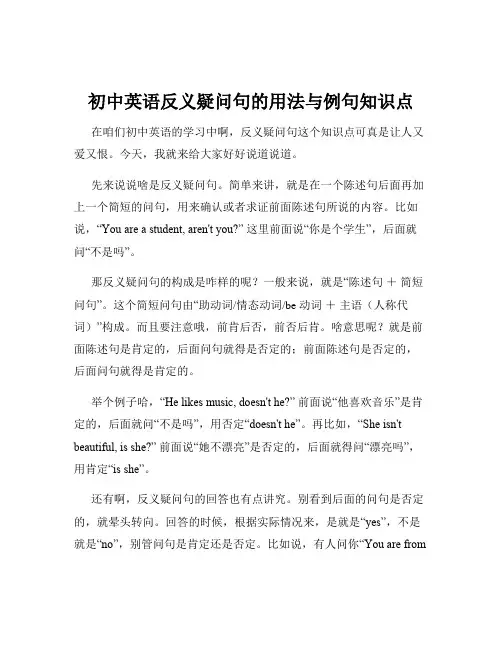
初中英语反义疑问句的用法与例句知识点在咱们初中英语的学习中啊,反义疑问句这个知识点可真是让人又爱又恨。
今天,我就来给大家好好说道说道。
先来说说啥是反义疑问句。
简单来讲,就是在一个陈述句后面再加上一个简短的问句,用来确认或者求证前面陈述句所说的内容。
比如说,“You are a student, aren't you?” 这里前面说“你是个学生”,后面就问“不是吗”。
那反义疑问句的构成是咋样的呢?一般来说,就是“陈述句+简短问句”。
这个简短问句由“助动词/情态动词/be 动词+主语(人称代词)”构成。
而且要注意哦,前肯后否,前否后肯。
啥意思呢?就是前面陈述句是肯定的,后面问句就得是否定的;前面陈述句是否定的,后面问句就得是肯定的。
举个例子哈,“He likes music, doesn't he?” 前面说“他喜欢音乐”是肯定的,后面就问“不是吗”,用否定“doesn't he”。
再比如,“She isn't beautiful, is she?” 前面说“她不漂亮”是否定的,后面就得问“漂亮吗”,用肯定“is she”。
还有啊,反义疑问句的回答也有点讲究。
别看到后面的问句是否定的,就晕头转向。
回答的时候,根据实际情况来,是就是“yes”,不是就是“no”,别管问句是肯定还是否定。
比如说,有人问你“You are fromChina, aren't you?” 如果你确实来自中国,那就回答“Yes, I am” 可别因为后面是“aren't you”就搞糊涂啦。
我还记得我上初中那会,有一次英语课上,老师正在讲反义疑问句。
当时老师举了个例子,“You have finished your homework, haven't you?”然后老师就点了我同桌起来回答。
我那同桌啊,平时英语就不太好,站起来一脸懵。
支支吾吾半天,最后来了一句:“I don't know” 全班同学都笑了,老师也哭笑不得,又给他耐心地解释了一遍。
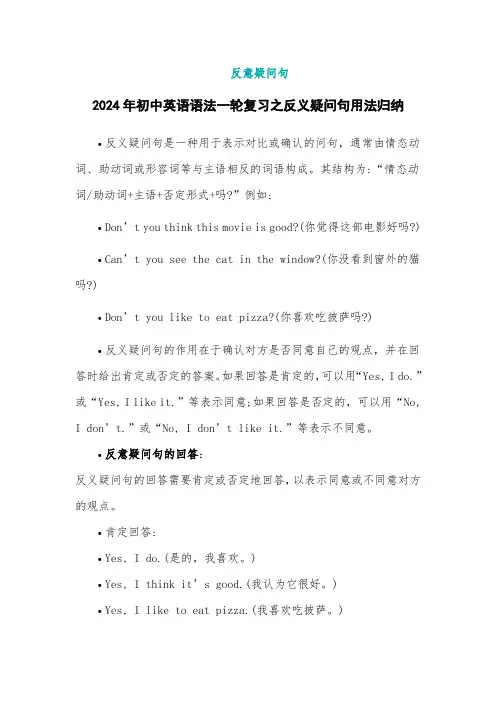
反意疑问句2024年初中英语语法一轮复习之反义疑问句用法归纳•反义疑问句是一种用于表示对比或确认的问句,通常由情态动词、助动词或形容词等与主语相反的词语构成。
其结构为:“情态动词/助动词+主语+否定形式+吗?”例如:•Don’t you think this movie is good?(你觉得这部电影好吗?) •Can’t you see the cat in the window?(你没看到窗外的猫吗?)•Don’t you like to eat pizza?(你喜欢吃披萨吗?)•反义疑问句的作用在于确认对方是否同意自己的观点,并在回答时给出肯定或否定的答案。
如果回答是肯定的,可以用“Yes, I do.”或“Yes, I like it.”等表示同意;如果回答是否定的,可以用“No, I don’t.”或“No, I don’t like it.”等表示不同意。
•反意疑问句的回答:反义疑问句的回答需要肯定或否定地回答,以表示同意或不同意对方的观点。
•肯定回答:•Yes, I do.(是的,我喜欢。
)•Yes, I think it’s good.(我认为它很好。
)•Yes, I like to eat pizza.(我喜欢吃披萨。
)•否定回答:•No, I don’t.(不,我不喜欢。
)•No, I don’t think it’s good.(不,我觉得它不好。
)•No, I don’t like to eat pizza.(不,我不喜欢吃披萨。
) •需要注意的是,在回答反义疑问句时,应该使用正确的语法和标点符号,以确保回答的准确性和清晰度。
回答反义疑问句的原则回答反义疑问句的原则是:肯定回答用“Yes, I do.”或“Yes, I think it’s good.”等表示同意;否定回答用“No, I don’t.”或“No, I don’t think it’s good.”等表示不同意。
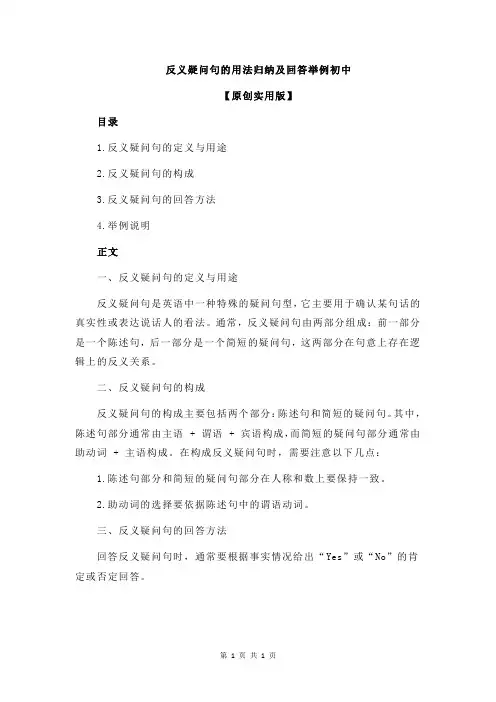
反义疑问句的用法归纳及回答举例初中
【原创实用版】
目录
1.反义疑问句的定义与用途
2.反义疑问句的构成
3.反义疑问句的回答方法
4.举例说明
正文
一、反义疑问句的定义与用途
反义疑问句是英语中一种特殊的疑问句型,它主要用于确认某句话的真实性或表达说话人的看法。
通常,反义疑问句由两部分组成:前一部分是一个陈述句,后一部分是一个简短的疑问句,这两部分在句意上存在逻辑上的反义关系。
二、反义疑问句的构成
反义疑问句的构成主要包括两个部分:陈述句和简短的疑问句。
其中,陈述句部分通常由主语 + 谓语 + 宾语构成,而简短的疑问句部分通常由助动词 + 主语构成。
在构成反义疑问句时,需要注意以下几点:
1.陈述句部分和简短的疑问句部分在人称和数上要保持一致。
2.助动词的选择要依据陈述句中的谓语动词。
三、反义疑问句的回答方法
回答反义疑问句时,通常要根据事实情况给出“Yes”或“No”的肯定或否定回答。
第1页共1页。
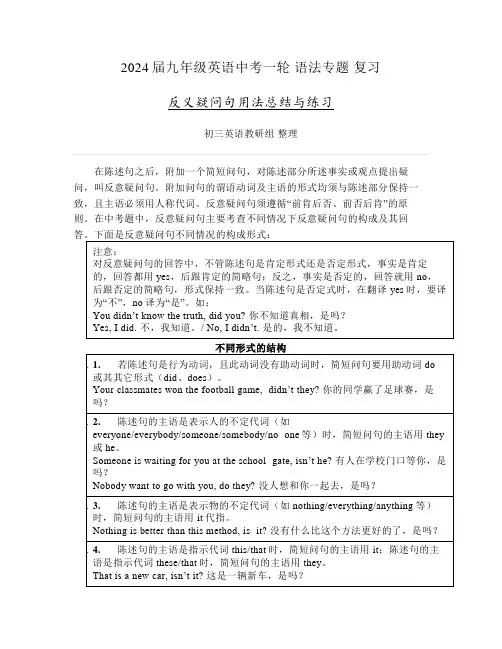
2024届九年级英语中考一轮语法专题复习反义疑问句用法总结与练习初三英语教研组整理在陈述句之后,附加一个简短问句,对陈述部分所述事实或观点提出疑问,叫反意疑问句。
附加问句的谓语动词及主语的形式均须与陈述部分保持一致,且主语必须用人称代词。
反意疑问句须遵循“前肯后否、前否后肯”的原则。
在中考题中,反意疑问句主要考查不同情况下反意疑问句的构成及其回专项练习:1. Tell me how to solve this problem, ____?A. do youB.don't youC. will youD.shan't you2. Half an hour ought to be enough time, ____?A. shouldn't itB. didn't theyC. oughtn't half an hourD. shouldn't half an hour3. They have to go to school now, ____?A. haven't theyB. don't theyC. hadn't theyD. did they4. When the car crashed, your brother escaped being hurt, ____?A. did itB.didn't itC. didn't heD. did he5. I'm dirty, ____?A. am IB.isn't IC. aren't ID.am not I6. That's the sort of the book you want,____?A. is thatB.isn't itC. is itD.isn't that7. I suppose you're not leaving, ____?A. are youB.don't youC. do youD.aren't you8. I wish to shake hands with you, ____?A shall I B.may IC. do ID.will I9. AIl these dictionaries are a great help to you, ____?A. aren't all theseB. are all these dictionariesC. aren't theyD. are they dictionaries10. The film that we saw last week was quite amazing, ____?A. was itB. wasn't itC. weren't weD. didn't we11. He has been writing letters all afternoon, but he should have finished them by now, ____?A. shouldn't heB. didn't youC. hasn't heD. has he12. We'd rather stay at home tonight, ____?A. isn't itB.hadn't weC. wouldn't weD. won't we13. There appeared to be no better way,____?A. didn't thereB. were thereC. did thereD. wasthere14. You had some trouble finding where Ilive, ____?A. do IB. hadn't youC. didn't youD. don't I15. He has his hair cut every month, ____?A. has heB.hasn't heC. does heD.doesn't he16. Jim told me that he would take a tripto Britain, ____?A. would heB.wouldn't heC. did heD.didn't he17. Jimmy dare not go to church, ____?A. does heB.dare heC. daren't heD. doesn't he18. She would have worked abroad if she'd had the chance, ____?A. wouldn't sheB. would sheC. hadn't sheD. has she19. Everyone is enjoying themselves, ____?A. aren't theyB. isn't everyoneC. does heD.is he20. Anyone can have a meal here, ____?A. can theyB. can't anyoneC. can't theyD. can anyone21. Your friend needs to e earlier,____?A. need heB.needn't heC. does heD.doesn't he22. Jenny scarcely es to visit you, ____?A. does sheB.doesn't sheC. do youD.don't you23. Let's listen to the radio program that the teacher mentioned, ____?A. don't weB.do weC. shall weD.shan't we24. The teacher had a talk with you, ____?C. did sheD.didn't she25. You think you're funny, ____?A. do youB. are youC. don't youD. didn't you26. Janet used to take part in labor in that village, ____?A. used sheB.did sheC. didn't sheD. should she27. What a beautiful flower, ____?A. doesn't itB. isn't itC. won't itD. is it28. No one will believe how difficult his work has been, ____?A. will heB.won't nobodyC. will theyD. won't they29. You must have made the mistake, ____?A. mustn't youB. haven't youC. didn't youD. hadn't you30. Learning how to repair puters takes a long time, ____?A. isn't itB. aren't theyC. doesn't itD. don't they31. Tom has milk with breakfast, ____?A. hasn't TomB. hasn't heC. doesn't TomD. doesn't he32. They must have stayed at hotel last night, ____?A. mustn't theyB. haven't theyC. didn't theyD. hadn't they33. Something'll have to be done about the air pollution, ____?A. won't itB.will itC. has itD.does it34. You must be hungry, ____?A. must youB.mustn't youC. are youD.aren't you35. She had the clothes cleaned, ____?C. didn't sheD. didn't her daughter36. There isn't anything wrong with the car, ____?A. is thereB.is itC. does itD.does there答案:15 CABCC610 BABCB1115 ACCBD1620 DBAAC2125 DACDC2630 CBABC3136 DCADCA。
反义疑问句1.陈述部分肯定句+疑问部分否定句(可记为前肯后否).例:They work hard, don’t they?Let's go to the supermarket ,shall we?2.陈述部分否定句+疑问部分肯定句(可记为前否后肯).例:You didn't go, did you?句子类型一种是反义的附加疑问句;一种是非反义的附加疑问句。
简单来说,就是“前肯后否”或“前否后肯”。
反义疑问句的答案1.前肯后否:回答时,如果情况属实,用Yes加上反问句的倒装肯定句;如果情况不属实,则用No加上反例如You were moved by your stud ents, weren’t反义疑问句you?情况属实:Yes, I was. 情况不属实:No, I wasn't2.前否后肯::回答时,如果情况属实,用No加上反问句的倒装否定句。
;如果情况不属实,则用Yes 加上反问句的倒装肯定句。
例如You did not go camping last Sunday,did you?情况属实:No,I didn't. 情况不属实:Yes,I did.句子结构1.陈述部分肯定式+疑问部分否定式可记为前肯后否定.They work hard, don’t they?2.陈述部分否定式+疑问部分肯定式可记为前否后肯定.句子类型:一种是反义的附加疑问句,一种是非反义的附加疑问句。
简单来说,就是“前肯后否”或“前否后肯”。
编辑本段读法规则反义疑问句陈述部分用降调,问句部分可升可降。
提问者对陈述部分把握较大时,问句部分用降调;反之用升调。
速记方法前肯后否,前否后肯,前be后be,前无be后加助(do,have),时态一致。
主语一般词语附加疑问句中主语用和主句一致的主语,用主格。
附加疑问句随从句。
不定代词当陈述部分的主语是(1)用one时,后面的疑问句可用one/he.(2)用no one时,后面附加疑问句中主语用they。
中考反义疑问句特殊句式-反义疑问句专题复习-反义疑问句反义疑问句结构:前否后肯,或前肯后否1.当陈述句部分的主语是不定代词no one,none,nobody,everyone,someone,everybody,somebody 等时,其附加疑问句的主语强调全部时可用they,强调个体时用he.No one phoned me while I was out,did they?Everyone is having a good time, aren`t they?Someone is waiting for you,isn`t he?2.陈述句的主语是复合不定代词everything,anything,something,nothing,附加疑问句部分主语用it.Everything goes well with you,doesn`t it?Nothing has been considered about this meeting,has it?3.不定代词one作主语,附加疑问句的主语在正式场合用one,非正式场合用you.One can`t be too careful,can one/you?4.当陈述句的主语是指示代词,附加疑问句主语要用相应的人称代词,即this/that用it,these/those用they.That was a hundred years ago,wasn`t it?Those are yours,aren`t they?5.陈述句部分为there be句型时,其后附加疑问句部分仍用there.There will be a special meeting tomorrow,won`t there?There used to be a lake here,usedn`t/didn`t there?6.情态动词must在反义疑问句中的用法,应由陈述部分的意义来决定。
四、反意疑问句1、结构陈述句+简短问句Eg: He is a student, isn’t he?前肯后否2、原则①:前肯后否;前否后肯。
否定词有:few, little, hardly, never, no, not,Seldom, neither, nothing, none,nobody, no one,scarcely等,如果前面有这些词,后面就不加not.②:前面用be动词、助动词、情态动词,后面也一样.前面如果没有be动词、助动词、情态动词,就去借助动词do, does, did,借哪一个由前面的谓语动词决定。
③: 前后在人称、时态上要一致。
简短问句必须用缩写形式④: 前面主语是this/that; these/those,问句主语用it/they代替⑤:前面主语是人名,问句中用相应的she/he/they代替⑥: 前面主语是表示“物”的不定代词,问句中主语用it代替. ⑦:含有think, believe, suppose, imagine, expect等动词后接宾语从句构成的主从复合句在构成反意疑问句时,视情况不同有两种不同的构成方式。
A: 当主句的主语为第一人称时,其后的简短问句应与从句相一致。
Eg: I don't think he is bright, is he?主句从句与从句一致B:当主句的主语为第二、三人称时,其后的简短问句则应与主句相一致(此时,否定只看主句,与从句无关...)Eg:They don't believe she's an engineer, do they?主句与主句一致Everything goes well, doesn’t it ?LiMing can speak English, can’t he ?This isn’t your pen, is it ?3、固定的形式1).Let’s…………,shall we ?2). Let us…………,will you?3). 祈使句…………, will you ?附练习:变反义疑问句1. You are not going home.2. You have got a green pencil.3. She can swim.4. He came here by bike.5. This is his book.6. John has learnt about China.7. Lucy can draw beautiful pictures.8. It isn’t a nice watch.9.There is a little milk in the glass.10. Jenny and Bill play basketball together after school.11. His sister does eye exercises every day.12. It’s a fine day today.13. He will go to Chengdu tomorrow.14. Her father had lunch at home.15. There is little water in the bottle .16. Let’s have a long talk.17. Jenny has never been late for school.18. Lily never went to the zoo by bus last year.19. Jim had few friends there.20.Kate has little bread for breakfast.21. Open the door 22. You’ve never seen dinosaur eggs23. His sister had a bad cough24. Mr. Green went to Shenzhen on business last week25. Danny can hardly understand any Chinese26. Don’t smoke in the meeting-room27. Miss Cheng will never forget her first visit to Canada28. The lady couldn’t say a word when she saw the snake29. he'll go shopping30.You'd like to go with me31. There are few apples in the basket.32.He can hardly swim.33.They seldom come late.34. I don't believe that he can translate this book.35. Your sister supposes she needs no help.36. She doesn't expect that we are coming so soon.37.Don't make much noise.。
反义疑问句知识点总结反义疑问句是英语中一种特殊的句型结构,由一个陈述句和一个简短的疑问句构成,用来表示说话者的疑惑、请求确认或强调说话者的观点。
本文将对反义疑问句的用法、结构、注意事项以及相关练习进行总结和概括。
一、反义疑问句的用法反义疑问句常用于口语交流中,用来询问对方的意见、请求确认信息或者表示说话者对某种情况的强调。
它可以通过改变陈述句的词序,使用“肯定→否定”或“否定→肯定”的方式来构成。
二、反义疑问句的结构1. 如果陈述句是肯定形式,疑问句部分为否定形式。
例如:- You are a student, aren't you?- They have finished their homework, haven't they?2. 如果陈述句是否定形式,疑问句部分为肯定形式。
例如:- He doesn't like coffee, does he?- We haven't seen the movie, have we?3. 如果陈述句中包含情态动词,反义疑问句中的疑问部分要使用原来的情态动词。
例如:- She will come to the party, won't she?- They can swim, can't they?4. 如果陈述句中使用了“let's”来表示建议,反义疑问句中疑问部分要使用“shall we”。
例如:- Let's go for a walk, shall we?5. 如果陈述句中使用了“there is”或“there are”,反义疑问句中疑问部分要使用“isn't there”或“aren't there”。
例如:- There is a book on the table, isn't there?三、注意事项1. 反义疑问句的结构要与陈述句的主语保持一致。
- She is a doctor, isn't she?(正确)- She is a doctor, aren't you?(错误)2. 主语如果是第三人称单数,疑问句的代词要使用对应的第三人称代词,即“he、she、it”。
反意疑问句反意疑问句是由两部分组成的,前一部分是对事物的陈述(即陈述句),后一部分是简短的提问(即简短疑问句),中间用逗号隔开。
如果前一部分用肯定句,后一部分就用否定疑问句;如果前一部分用否定句,后一部分就用肯定疑问句。
两部分的人称和时态要一致。
其回答是用yes或no来表示。
一、含be(is, are, was, were)动词的反意疑问句其句型是:句型1:主语+ be+其它,isn’t(aren’t, wasn’t, weren’t)+ 主语?句型2:主语+ be not+其它,is(are, was, were) + 主语?① You are from America, aren’t you? Yes, I am. No, I’m not.② It isn’t very cold today, is it? Yes, it is. No, it isn’t.③ Tom was away yesterday, wasn’t he? Yes, he was. No, he wasn’t.④ The Green weren’t at home last nigh t, were they?Yes, they were. No, they weren’t.⑤ Mary is reading English now, isn’t she? Yes, she is. No, she isn’t.⑥ Your parents aren’t going to have a party this Sunday, are they?Yes, they are. No, they aren’t.⑦ Th e girls were singing when the teacher came in, weren’t they?Yes, they were. No, they weren’t.注意:There be句型① There is an old picture on the wall, isn’t there?Yes, there is. No, there isn’t.② There aren’t any children in the room, are there?Yes, there are. No, there aren’t.③ There wasn’t a telephone call for me, was there?Yes, there was. No, there wasn’t.④ There were enough people to pick apples, weren’t there?Yes, there were. No there weren’t.二、行为动词的一般现在时的反意疑问句其句型是:句型1: 主语+动词原形+其它,don’t I(you, we, they)?句型2: 主语+ don’t+动词原形+其它,do I(you, we, they)?句型3: 主语+动词第三人称单数+其它,doesn’t he(she, it)?句型4: 主语+ doesn’t+动词原形+其它,doeshe(she, it)?① You often watch TV in the evening, don’t you? Yes, I do. No, I don’t.② The students don’t study hard, do they? Yes, they do. No, they don’t.③ Mary studies Chinese hard, doesn’t she? Yes, she does. No, she doesn’t.④ The boy doesn’t often go to school by bike, does he?Yes, he does. No, he d oesn’t.⑤The first class begins at eight, doesn’t it? Yes, it does. No, it doesn’t.三、行为动词的一般过去时的反意疑问句其句型是:句型1: 主语+动词过去式+其它,didn’t+主语?句型2: 主语+didn’t+动词原形+其它,did +主语?① You watched TV last night, didn’t you? Yes, I did. No, I didn’t.②Jim’s parents didn’t go to Hong Kong last month, did they?Yes, they did. No, they didn’t.③ The rain stopped, didn’t it? Yes, it did. No, it didn’t.④Mr. Clarke didn’t buy a car, didn’t he? Yes, he did. No, he didn’t.四、一般将来时的反意疑问句其句型是:句型1: 主语+will+动词原形+其它,won’t+主语?句型2: 主语+ won’t +动词原形+其它,will +主语?①The boys will play games, won’t they? Yes, they will. No, they won’t.② It won’t stop raining, will it? Yes, it will. No, it won’t.③ Mr. Smith will visit our school next week, won’t he? Yes, he will. No, he won’t.注意:There be句型的一般将来时① There will be a basketball match tomorrow, won’t there?Yes, there will. No, there won’t.② There won’t be too much pollution in the future, will there?Yes, there will. No, there won’t.五、现在完成时的反意疑问句其句型是:句型1: 主语+have+动词过去分词+其它,haven’t+主语?句型2: 主语+ haven’t +动词过去分词+其它,have +主语?句型3: 主语+has+动词过去分词+其它,hasn’t+主语?句型4: 主语+ hasn’t +动词过去分词+其它,has +主语?① You have been to Shanghai before, haven’t you? Yes I have. No, I haven’t.② You haven’t been to Shanghai before, have you? Yes I have. No, I haven’t.③Jack has done his homework, hasn’t he? Yes, he has. No, he hasn’t.④Jack hasn’t done his homework, has he? Yes, he has. No, he hasn’t.六、现在完成进行时的反意疑问句其句型是:句型1: 主语+have been+动词现在分词+其它,haven’t+主语?句型2: 主语+ haven’t been +动词现在分词+其它,have +主语?句型3: 主语+has been +动词现在分词+其它,hasn’t+主语?句型4: 主语+ hasn’t been +动词现在分词+其它,has +主语?① You have been skating for five hours, haven’t you? Yes, I have. No, I haven’t.② You haven’t been skating for five hours, have you? Yes, I have. No, I haven’t.③ Bob has been collecting kites since 1999, hasn’t he? Yes, he has. No, he hasn’t.④ Bob hasn’t been collecting kites since 1999, has he? Yes, he has. No, he hasn’t.七、含有情态动词的反意疑问句其句型是:句型1: 主语+情态动词+动词原形+其它,情态动词否定形式+主语?句型2: 主语+情态动词否定形式+动词原形+其它,情态动词+主语?① You can speak French, can’t you? Yes, I can. No, I can’t.②They can’t understand me, can they? Yes, they can. No, th ey can’t.③ Ann could swim when she was six, couldn’t she? Yes, she could. No, she couldn’t.④ The students must study hard, mustn’t they? Yes, they must. No, they needn’t.注意:You must go home now, needn’t you? Yes, I must. No, I needn’t.★值得注意的是有时英语的谓语动词并不用否定式(即没加上not),而是用上了“never, little, few, hardly, nothing, nobody”等词,这时该陈述句也属于否定句,因此,反意疑问句的后半部分应用肯定疑问式。
① You have never been to Beijing, have you? Yes, I have. No, I haven’t.② Mr. Fat has few friends here, does he? Yes, he does. No, he doesn’t.③There is little milk in the bottle, is there? Yes, there is. No, there isn’t.④He could do nothing, could he? Yes, he could. No, he couldn’t.八、祈使句用于反意疑问句中这种类型较特殊,前一部分是祈使句,后一部分是肯定疑问形式。
回答也较灵活。